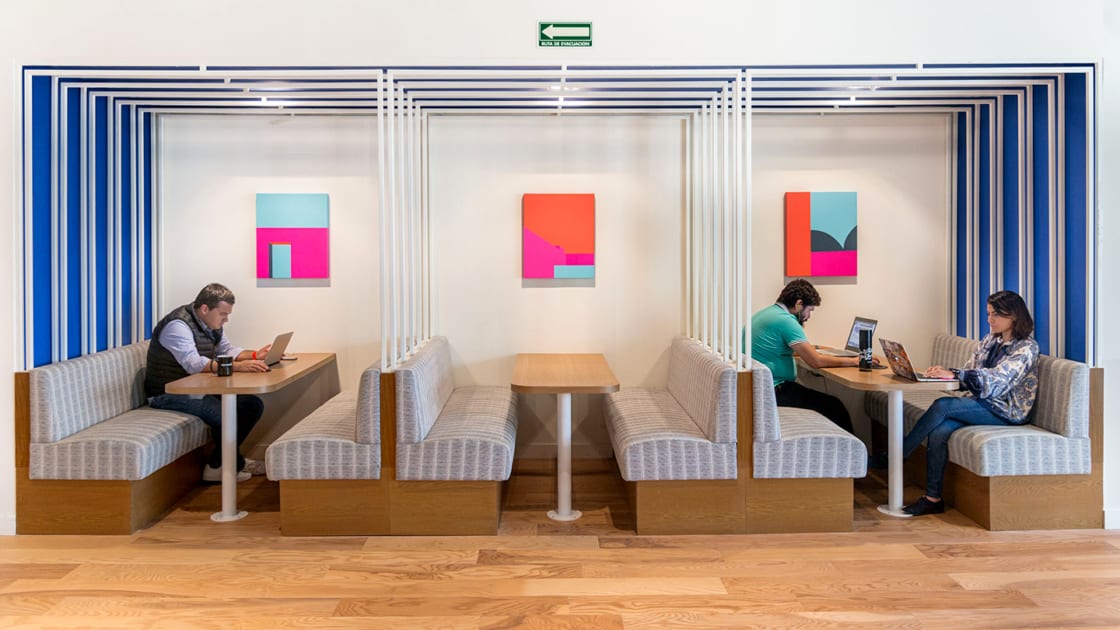Fitness and lifestyle brand Athleta knows the value of parents and children playing sports together. On April 25, the retailer joined forces with WeWork to bring a yoga and movement class to those families celebrating Take Our Sons and Daughters to Work Day at WeWork Chelsea HQ in New York City.
Beyond Athleta, a new crop of athletic programs is translating exercise into something parents and their children can—and should—do together.
For some families, this is already second nature. Vadim Shoykhet’s parents started Physique Swim School in New Jersey in 1997 after his family immigrated to the U.S. from the former Soviet Union, where his mother and father were professional swim coaches. In 2004, Shoyket moved to New York to attend college, and he brought Physique Swim School to Manhattan with him.
In the 15 years since, Shoyket has watched his younger students—many of whom he taught to swim himself—grow up, and has seen how the sport has affected their development into adulthood.
“When children learn to swim, they’re doing themselves more favors than simply learning how to navigate through the water,” says Shoyket, a member at New York’s WeWork 25 Broadway. “Swimming skills can help a child develop the mental, emotional, and physical strength necessary to develop and grow into a healthy and successful adult.”
According to Shoyket, a recent study in Australia and New Zealand showed that children who were engaged in swimming scored significantly better than the general population on cognitive language skills and mental development. And swimming, as with other physical activities, also helps improve coordination and balance, and develop muscle tone.
Physique Swim School allows children to start swimming at an early age, offering “Me & My Shadow”parent-child classes for kids as young as 4 months old. The trust that materializes in the pool between parents and their young children is palpable, and according to Shoyket, it can last a lifetime.
“The bond that the child creates with their parents in the water really grows outside the water, as well,” he says. “As the kids get older, they’re able to transition into working with a teacher. It’s the building block that allows them to be open to receiving instructions from an instructor.”
As children progress beyond swim floaties and paddle toward adolescence, that bond is more important than ever. At Mentor Foundation USA, an organization that works to prevent and reduce youth substance abuse and promote health and wellbeing, president and CEO Michaela Pratt sees that firsthand.
Mentor Foundation USA estimates that the quality of parent-child relationships is 10 times more powerful than demographics in predicting whether children develop critical character strengths, and Pratt believes that goes back to the investment parents make in their relationships with their children. Something simple like volunteering to coach their child’s little league team—one of the recommendations made to parents—goes a long way.
“Parents understand what an enormous responsibility, but also ability, they have to guide their young children,” says Pratt, a member at WeWork 1775 Tysons Blvd in Washington, D.C. “It’s about combining the work world to fit your needs to be the best at what you can be, not only at work, but also at home, and combine the two to have a healthier life for yourself and your children.”
Debra Giunta founded dance education company Design Dance in 2008 with a similar mission: to bring dance education to children through partnerships with schools and community centers. Growing up dancing in the south suburbs of Chicago, Giunta, a member at Chicago’s WeWork 1 W Monroe St, found dance to be uniquely therapeutic in a way she hopes to pass along to children and their parents.
“Dance is both a physical activity and an artistic activity, so when we move, we can really access emotions and thoughts that we’re not accessing regularly,” she says. “There’s a lot of feelings and memories that live in the body that we’re not consciously thinking about, but when we move, we’re able to access those things.”
Like Physique Swim School’s “Me & My Shadow” course, Design Dance advocates for tandem parent-and-child movement. In 2017, Giunta launched an offshoot for children between ages 3 and 5 called The Groove, which focuses on the needs of families affected by disability.
“A lot of people think they need to learn how to dance in order to engage with dance,” she says. “But I always use the analogy of a wedding. If you go to a wedding, you have a bunch of people who would never call themselves dancers, but who hear music and get up and dance and have a great time.”
Brands and programs may make it seamless for parents to incorporate physical activity into their family lives. But there’s no need to wait until Take Our Sons and Daughters to Work Day to enjoy the benefits of. Shoyket, for one, encourages parents to incorporate swimming beyond the lap pool and into their family’s leisure time; look for a local pool’s open-swim hours or organize a beach day one Saturday once summer hits.
“When parents can find a way to incorporate that into their family life,” says Giunta, “it can be really impactful throughout the course of their child’s life.”
Below, three ways for parents to incorporate movement into their family’s everyday lifestyle:
Make long road trips a dance party. While the kids are safely strapped into the backseat, Giunta recommends putting on your family’s favorite playlist and grooving to the beat of the music—as much as the seatbelt will allow, of course.
Put on a yoga class on YouTube and turn the living room into a studio. There are plenty of options for full families or even just for a parent and child. What’s even better is that many of these tutorials are 10 minutes or less. Your younger children will be pleased.
When the weather cooperates, plan a beach (or pool) outing. Make a day of it. “Families can incorporate swim through leisure time—the love for water—by going to the beach, a pool, or a water park,” says Shoyket. “It creates a bonding experience for them.” Pack plenty of snacks and, obviously, SPF.







